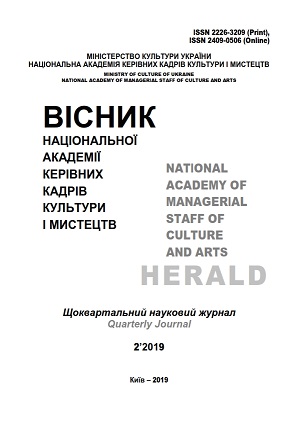Composition of Orchestra and Principles of Orchestral Writing in Concerto Grosso G-Dur № 2 by Johann Georg Pisendel
Composition of Orchestra and Principles of Orchestral Writing in Concerto Grosso G-Dur № 2 by Johann Georg Pisendel
Author(s): Vadim Yaroslavovych HorbalSubject(s): Theatre, Dance, Performing Arts, Music, History of Art
Published by: Національна академія керівних кадрів культури і мистецтв
Keywords: Johann Georg Pisendel; German baroque orchestra; genre Concerto grosso; principles of orchestral writing; tutti; trio;
Summary/Abstract: The purpose of a work. The article examines the principles of orchestral writing in the instrumental works of J. G. Pisendel (1687-1755) in the context of the genre evolution of German orchestral music of the first half and middle of the eighteenth century. Material for analysis - Concerto Grosso number 2 G-dur. The methodology is an integrated approach and is based on the use of analytical and comparative methods. Scientific novelty. During the first half and middle of the eighteenth century German instrumental music sees an intense solo performance development and the role of individual musician’s skills is rising. Development of new genres, which can demonstrate performing skills, continues. One of them was a genre of instrumental concert, in which a triad "concerto grosso – instrumental solo concert – concert symphony" clearly reflected phased transition from Baroque to early classical style. The analyzed work by J. G. Pisendel as all the legacy of the artist as a whole, represents the initial phase of the process. The conclusions. Concerto grosso G-dur № 2 is written in typical concert form, with multiple alternation of ritornellos performed by all chapel instruments and musical constructions performed by a separate group of instrumentalists – so called trio. The composer tries to follow tradition and carefully constructs a typical composition of multiple bright ritornello in different keys and episodes of solo-ensemble type, which contrast in texture the full-toned tutti parts. Composition of the orchestra: 2 violins, a viola, bass (cello and harpsichord), 2 flutes, 2 oboes, bassoon, two horns. The trio is composed of two flutes, two oboes and bassoon as soloists as well as instruments of basso continuo group. Flutes and oboes solo in turns, but are often combined in a joint sound, as a result the trio becomes a quintet featuring masterfully interpreted woodwind instruments. The main function of tutti is to present the main theme, while the ensembles’ role is reduced to saturation the texture with virtuoso element.
Journal: Вісник Національної академії керівних кадрів культури і мистецтв
- Issue Year: 2019
- Issue No: 2
- Page Range: 351-355
- Page Count: 5
- Language: English

